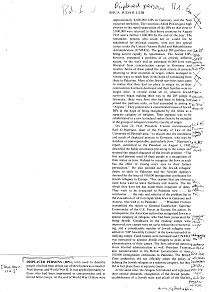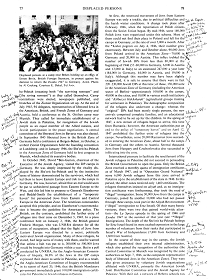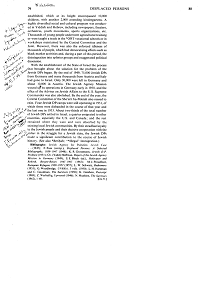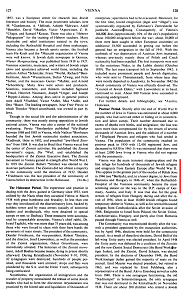Displaced Persons (DPs) and DP camps in central Europe 1945-1953
Jewish refugees after 1945 because anti-Semitism in Eastern Europe does not stop -
DP camps in the "American" zones of Germany, Austria and Italy - the administration of the camps
presentation by Michael Palomino (2007)
| Teilen
/ share: |
Facebook |
|
Twitter
|
from:Displaced Persons (DPs)
-- Displaced Persons; In: Encyclopaedia Judaica 1971, vol. 6
-- Vienna; In: Encyclopaedia Judaica 1971, vol. 16
(from: Displaced Persons; In: Encyclopaedia Judaica 1971, vol. 6)
<Displaced Persons (DPs), term used to describe people who had been driven out of their homes as a result of Nazi decrees and World War II. [[and after World War II by pogroms of anti-Semitic fascist Poles]]. It was applied primarily to those who had been imprisoned in concentration and in forced labor camps.
At the end of World War II there were (col. 75)
approximately 8,000,000 DPs [[of all religions]] in Germany and the Nazi occupied territories. The victorious Allied Powers gave high priority to the rapid repatriation of the DPs so that close to 5,000,000 were returned to their home countries by August 1945 and a further 1,000,000 by the end of the year. The remainder, persons who could not or would not be repatriated for political reasons [[2 mio.]], were put into special camps under the United Nations Relief and Rehabilitation Administration (UNRRA).
[1944: Jews returning back see they are not wanted any more or they are alone - drive to the DP camps for special refugee category]
The general DP problem was being solved rapidly by repatriation. The Jewish DPs, however, presented a problem of an entirely different nature. At the war's end an estimated 50,000 Jews were liberated from concentration camps in Germany and Austria. Some of these joined the main stream of persons returning to their countries of origin; others managed in various ways to reach Italy in the hope of continuing from there to Palestine. Most of the Jewish survivors soon came to realize that they had no place to return to, as their communities had been destroyed and their families were no longer live. A reverse trend set in, wherein Jewish survivors began making their way to the DP camps in Germany; these were Jews who had been in hiding, had joined the partisan units, or had succeeded in posing as "Aryans". They joined into a concentrated mass of Jewish DPs in the hope of being recognized by the Allies as a separate category of refugees. Their purpose was to be rehabilitated in a new homeland rather than to be included in the groups of refugees treated by country of origin.
<Perhaps a million Jewish refugees were alive in camps in Europe in May 1945.>
(from: Encyclopaedia Judaica 1971: Zionism, vol. 16, col. 1058)
<The end of the war in Europe in May 1945 [...] was necessary to aid in the rehabilitation of hundreds of thousands of survivors of Nazi camps.>
(from: Encyclopaedia Judaica 1971: Zionism; vol. 16, col. 1087)
[1945: Harrison's investigation: The question of the recognition as a nationality of "Jew" - emigration]
On June 22, 1945, President Truman commissioned Earl G. Harrison, dean of the Faculty of Law of the University of Pennsylvania, "to inquire into the conditions and needs of displaced persons in Germany, who may be stateless or non-repatriable, particularly Jews." Harrison's report, submitted to the President on August 1, 1945, described the harsh conditions prevailing in the camps and stressed the special character of the Jewish problem: "The first and plainest need of these people is a recognition of their status as Jews. Refusal to recognize the Jews as such has the effect of closing one's eyes to their former persecution."
He also pointed out the Jewish refugees' desire to settle in Palestine and the *Jewish Agency's demand for the issue of 100,000 immigration certificates for Jewish refugees in Europe. "For reasons that are obvious most Jews want to leave Germany and Austria. The life which they have led has made them impatient of delay. They want to be evacuated to Palestine now ...
In conclusion ... the only real solution of the problem lies in the evacuation of all non-repatriable Jews in Germany and Austria, who wish it, to Palestine ..."
[[And the Arabs and the Palestinians are not asked...]]
[since 1945: DP Camps set up - immigration certificates for Palestine - special Jewish camps]
President Truman transmitted the report to General Eisenhower, Supreme Commander of the U.S. Forces in Europe, for action. In consequence, the American authorities recognized Jews as a special category of refugees, who had been persecuted for being Jewish. Conditions in the existing camps were improved, new camps were set up to reduce the overcrowding, and a considerable number of Jewish refugees were settled in "DP Assembly Centers" in the towns instead of in outlying camps. Food rations were increased and UNRRA was instructed to appoint Jewish refugees to posts in the administration of their camps. The Jews achieved autonomous internal administration as well.
President Truman also recommended to the British Government to issue 100,000 immigration certificates to Palestine. The British Zone authorities did not officially adopt the policy of defining the Jewish refugees as a separate category, but they did in fact place them in separate camps.
[Postulations for rights of recognition - Zionist organizations in the camps - claim for a Jewish state in Palestine]
At the same time, the refugees formulated and expressed their central demands: recognition of the Jewish people, establishment of a Jewish state and aliyah of the She'erit (col. 76)
ha-Peletah (meaning both "the surviving remnant" and "the saving remnant") as they called themselves. Camp committees were elected, newspapers published, and branches of the Zionist Organization set up. At the end of July 1945, 94 delegates, representatives of liberated Jews in the American, British, and French Zones of Germany and Austria, held a conference at the St. Ottilien camp near Munich. They called for immediate establishment of a Jewish state in Palestine, for recognition of the Jewish people as an equal member of the Allied nations, and Jewish participation in the peace negotiations. A central committee of the liberated Jews in Bavaria was also elected.
[Parliamentary organization of the DP-Jews]
In September 1945 liberated Jews in the British Zone of Germany held a conference at Bergen-Belsen; in October, a unified Zionist Organization held the founding convention at Landsberg; and in January 1946, the She'erit ha-Peletah in the American Zone of Germany held its first congress in Munich, which elected its executive bodies.
[October 1945: David Ben-Gurion in Germany foresees the block of the Soviet border - suggesting of a "temporary haven" in the "US" zone]
In October 1945, David *Ben-Gurion, chairman of the Executive of the Jewish Agency, visited the DP camps in Germany. He was deeply impressed by the vitality displayed by the She'erit ha-Peletah and by the instinctive sense of history demonstrated by the survivors, which had led them to leave Eastern Europe and trek to the camps in Germany. He was, however, afraid that an end would soon be put to unhindered passage from Eastern Europe to the West, and this led him to propose to Generals Eisenhower and Beddel-Smith the establishment of a "temporary haven" for persecuted Jews from Eastern and Central Europe in the American Zone.
[British zone is blocked - Morgan states that a secret organization is working for Jewish flight - 3-500,000 expected]
The American commanders accepted this principle, and on Eisenhower's recommendation it became the guideline for American policy. The British, on the contrary, prohibited the further entry of refugees into their zone on December 5, 1945. in a press conference held on January 2, 1946, the British general Frederic Morgan, who was UNRRA director for all the zones of occupation, alleged that the flight of Jews from Eastern Europe was directed by a secret, politically motivated Jewish organization. Many of these refugees, he stated, had large sums of money with them, and he warned that unless a halt was put to it, 300,000 to 500,000 Jews would be brought into Germany within a year.
[96.8% of Jewish DPs say they want to Palestine - 100,000 immigration certificates]
But in a poll conducted by UNRRA, for the Anglo-American Commission of Inquiry, 96.8% of the Jews in the DP camps expressed their desire to settle in Palestine, and as a result, the Anglo-American Committee of Inquiry recommended in its report of April 20, 1946, that the British Mandatory government immediately grant 100,000 immigration certificates for Palestine to Jewish refugees in Europe. (col. 77)
[Repatriation of some 140,000 Polish Jews from inner "SU" - big influx of Polish Jews after Kielce pogrom]
At first, the westward movement of Jews from Eastern Europe was only a trickle, due to political difficulties and the harsh winter conditions. A change took place after February 1946, when the repatriation of Polish citizens from the Soviet Union began. By mid-1946, some 140,000 Polish Jews were repatriated under this scheme. Most of them could not find their place in Poland and left for the camps in Germany, at the rate of over 5,000 a month.
After the *Kielce pogrom on July 4, 1946, their number grew enormously. Between July and October alone, 90,000 Jews from Poland arrived in the American Zone - 70,000 in Germany and 20,000 in Austria. This influx trebled the number of Jewish DPs from less than 80,000 at the beginning of 1946 (55-60,000 in Germany, 6,000 in Austria and 12,000 in Italy) to an estimated 247,000 a year later (184,000 in Germany, 44,000 in Austria, and 19,000 in Italy).
Although this number may have been slightly exaggerated, it is safe to assume that there were in fact 220-230,000 Jewish DPs at this time; of these, 150,000 were in the American Zone of Germany (including the American sector of Berlin) - approximately 100,000 in the camps, 40,000 in the cities, and 10,000 in various youth institutions and "Kibbutzei Hakhsharah" (agricultural groups training for settlement in Palestine).
The demographic composition of the refugees also underwent a change: whereas the "original" DPs had been mostly single persons, the new arrivals comprised complete families, and an educational network had to be set up for the children.
[1947: Stream of refugees from Romania - haven closed - and Jews from Hungary and Czechoslovakia]
In the spring of 1947, a new stream of refugees began to arrive, this time from Romania; However, the American authorities put an end to the policy of "temporary haven" and on April 12, 1947 prohibited the further entry of refugees into the camps. Nevertheless, some 20,000 Romanian Jews succeeded in entering the American Zone, about half to the camps in Germany and the others to Austria. Several thousand Jews from Hungary and Czechoslovakia also succeeded in infiltrating into the zone.
[Palestine remains closed - illegal immigration for war in Israel]
International pressure to facilitate the resettlement of the Jewish refugees in Palestine did not succeed in persuading the British Government to open the gates. Only the British Zone received a monthly quota of immigration certificates as of March 1947, and in "Operation Grand National" some 6,000 Jewish refugees from this zone arrived in Palestine up to the establishment of the state in 1948. In this period, the other zones received only 1,460 certificates. The refugees themselves insisted on aliyah and, as no immigration certificates were forthcoming, they took the road of "illegal" immigration.
Some 30,000 Jews from the camps in Germany, joined by another 10,000 who had not passed through these camps, took part in the Aliyah Bet movement ("illegal" immigration to Erez Israel). Of their many heroic ventures, there were two that gained world-wide attention - the La Spezia episode in the spring of 1946 and Exodus 1947 in the summer of that year (see "*Illegal" Immigration). The depth of the She'erit ha-Peletah feelings for Erez Israel found its most exalted expression in the large number of volunteers from their ranks that participated in Israel's War of Independence (7,800 from Germany and 1,600 from Austria).
[The DP camps administration - schools - cultural programs in the camps]
In the course of their stay in the camps, the Jewish refugees established their own internal administration which also gained the recognition of the authorities (the Central Committee in Munich was recognized by the zone authorities on Sept. 7, 1946, as the competent representative body of liberated Jews in the American Zone). They were also given assistance by voluntary Jewish organizations affiliated with UNRRA, primarily the American Jewish Joint Distribution Committee and the Jewish Agency for Palestine.
With their aid, a network of Hebrew schools was (col. 78)
established, which at its height encompassed 10,000 children, with another 2,000 attending kindergartens. A highly diversified social and cultural program was conducted in Yiddish and Hebrew, including newspapers, theaters, orchestras, youth movements, sports organizations, etc. Thousands of young people underwent agricultural training or were taught a trade in the *ORT vocational schools or in workshops maintained by the Central Committee and the Joint. However, there was also the enforced idleness of thousands of people, which had demoralizing effects such as black market activities and, during a part of this period, the disintegration into splinter groups and exaggerated political dissension.
[since 1948: Emigration to Israel - 1950-1953: DP camps closing down]
With the establishment of the State of Israel the process that brought about the solution for the problem of the Jewish DPs began. By the end of 1949, 75,000 Jewish DPs from Germany and many thousands from Austria and Italy had gone to Israel. Only 30,000 were left in Germany and about 10,000 in Austria.
The Jewish Agency Mission wound up its operations in Germany early in 1950, and the office of the Adviser on Jewish Affairs to the U.S. Supreme Commander was also abolished. By the end of the year, the Central Committee of the She'erit ha-Peletah also ceased to exist. Four Jewish DP camps were still operating in 1951, of which three were disbanded in the course of that year and the last one in 1953.
About two-thirds of the total number of Jewish DPs settled in Israel; a quarter emigrated to other countries, especially the U.S. and Canada; and the rest remained where they were and were absorbed by the existing local Jewish communities. By their steadfast loyalty to the Jewish people and their decisive cooperation with the vishuv [[Jews in Palestine before Herzl Israel foundation, before 1948]] in the struggle for a Jewish state, the Jewish DPs made a significant contribution to the course of Jewish history. (See also *Berihah; * "Illegal" Immigration).
[[And the Arabs and the Palestinians were not asked]].
Bibliography
-- Jewish Agency for Palestine: Jewish Case ... (1947)
-- F. Fuss (comp.): Displaced Persons: A selected Bibliography, 1939-1947 (1948)
-- K. R. Grossmann: Jewish D.P. Problem (1951)
-- Ch. (Yahil) Hoffman: Report of the Jewish Agency Mission in Germany (1949)
-- S. E. Bloch (ed.): Holocaust and Rebirth. Bergen-Belsen 1945-1964 (1965)
-- M. J. Proudfoot: European Refugees 1939-1952 (1957)
-- L. W. Schwarz: Redeemers (1953)
-- G. Woodbridge: UNRRA, 3 vols. (1950)
-- L. H. Hardman and C. Goodman: The Survivors (1958)
-- K. Gershon: Postscript (1969)
-- Z. Warhaftig: Uprooted (1946)
-- N. Muehlen: The Survivors (1962), 1-40
[CH. Y.]>
| Teilen
/ share: |
Facebook |
|
Twitter |
Sources
Encyclopaedia Judaica: Displaced Persons, vol. 6, col. 75-76
Encyclopaedia Judaica: Displaced Persons, vol. 6, col. 77-78
Encyclopaedia Judaica: Displaced Persons, vol. 6, col. 79-80
Jewish survivors and DPs in Vienna since 1945
(from: Vienna; In: Encyclopaedia Judaica 1971, vol. 16)
<Postwar Period. Shortly after the end of World War II the number of Jews in Vienna was estimated at about 4,000 people, who had survived either in hiding or in concentration and labour camps. Their number decreased due to excess of deaths over births, and emigration; the loss was soon more than compensated for by the return of several thousands of Austrian Jews, and the addition of a number of *Displaced Persons and refugees who had settled in Vienna. The population of the community reached its postwar peak in 1950 with 12,450 registered Jews, and decreased to 8,930 in 1965. It was estimated that there were at least 2,000 Jews living in Vienna who did not register with the community.
Vienna was the main transient stopping-place and the first refuge for hundreds of thousands of Jewish refugees and emigrants from Eastern Europe after World War II. This applies to the greater part of the exodus of Polish Jews in 1946 (see *Berihah), and, to a lesser degree, to Jews from Rumania [[Romania]] and Hungary in 1946-47, when the Rothschild-Hospital of the Viennese community became the main screening station on the way to the D.P. camps of Germany, Austria, and Italy.> (col. 128)
[[In other regions of the "American" zones there were other towns with against hundreds of thousands of Jewish refugees and emigrants from Eastern Europe, e.g. around Munich]].
Sources
Encyclopaedia Judaica 1971: Vienna, vol. 16, col. 127-128, with the indication of hundreds of thousands of Jewish refugees and emigrants from Eastern Europe after World War II. in Vienna
^






